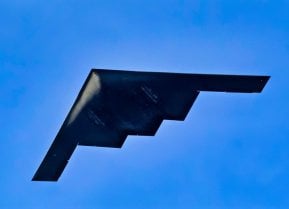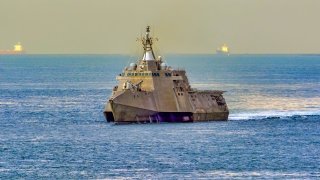Littoral Combat Ship: The U.S. Navy's Nightmare That Won't End
The Littoral Combat Ship (LCS) program, a post-Cold War initiative aimed at enhancing the U.S. Navy's green-water capabilities, has become a symbol of defense procurement failure.
Summary: The Littoral Combat Ship (LCS) program, a post-Cold War initiative aimed at enhancing the U.S. Navy's green-water capabilities, has become a symbol of defense procurement failure. Initially costing $500 million per ship, the LCS was envisioned as a versatile, modular warship adaptable to various missions with a small crew and fast maneuverability. However, the reality has been far from the promise. Several LCS have been retired early, and others are frequently out of action, earning the nickname "Permanent Dry Dock Club" due to their frequent need for repairs. This situation underscores a broader issue of defense spending inefficiency, with high expectations leading to underperforming assets. As the U.S. enters a competitive global environment, the legacy of such missteps raises concerns about the military's readiness and strategic capabilities.
The Littoral Combat Ship: A Tale of Naval Ambition and Reality
Whenever a defense contractor or a Pentagon spokesperson starts talking about their new “cost-effective” program, just know that it’s a bunch of malarkey. The program is usually going way over budget, the product itself will not be as good as promised, and the systems will be delivered late – meaning that We, The People, as well as our military, are about to get hosed.
Such is the case with the Littoral Combat Ship (LCS). The program introduced warships so awful that many in the U.S. Navy have taken to calling them "Little Crappy Ships.”
Littoral Combat Ship: The Navy Wanted a Green-Water Navy
It seems strange today, with all the talk about China’s threat to the U.S. Navy and the possibility of a great-power war erupting, but there was a time in recent memory when the Navy was obsessed with the notion of building what is known as a green-water navy.
The Cold War ended with most of the world’s powers laid low. Only America stood tall as the last remaining superpower. The enemies of the United States were a combination of terror groups and rogue states. Their power and reach were limited.
So the U.S. military needed to devise new strategies and weapons to fight that enemy. Since these enemies had limited ability to project power, the Navy needed to get closer to where they were.
A green-water navy is basically a group of warships that operates very near the coastlines of other countries, or of its own. It cannot conduct independent operations in the blue waters of the deep oceans. So these smaller warships bring the fight to the enemy’s shores. The concept made sense in the 1990s and early 2000s.
In theory, the Navy still needs a much greater green-water capability. Sadly, the Navy’s war planners chose to meet the demand by investing in the LCS at the cost of a whopping $500 million per ship.
The LCS: A Swiss Army Knife of a Warship
The origins of the LCS can be traced back to 2002, when then-head of U.S. Naval Operations Adm. Vernon Clark visited a Danish destroyer. During that visit, he noted how the Danes swapped the warship’s weapons in less than 40 minutes. The American admiral quickly envisioned creating a Navy warship that could operate like a Swiss Army knife.
The warship’s parts would be interchangeable depending on the mission. The LCS would be operated by a crew of 40 sailors — far smaller than any other warship the U.S. Navy had. It would be fast and lightly armed, but the plug-and-play model of the LCS would revolutionize Navy operations.
After nearly two decades of commitment, the Navy has already begun retiring several of the LCSs, even though they are among the youngest warships in the Navy's fleet. Others are falling apart because they were never able to meet the demands of having interchangeable parts. As a result, the LCS is an even bigger boondoggle than the Zumwalt-class destroyer.
The LCS and the Zumwalt class represent two evolutionary dead ends for the Navy. More painfully, they could have been avoided.
Almost from the start of the research and development phase of the LCS program, multiple high-level engineers on the project began voicing their concerns. Nevertheless, the Navy had decided. The bureaucracy was totally behind the LCS concept. There would be no stopping it.
Too bad for everyone that, in this case, the naysayers were proven correct.
The LCS: Standing Members of the Permanent Dry Dock Club
The LCS program was a total failure. The Navy’s next generation of warships are not currently sailing the high seas, despite having been operational since 2016. They spend more time in port being repaired, prompting some Navy officers to nickname these warships "Dry Dock One," since they spend so much more time being repaired than they do at sea.
What has that $500 billion per LCS unit gotten us? A whole lot of nothing. The Navy attempted to make the LCS a jack of all trades, and ultimately the LCS was a master of none.
The Littoral Combat Ship is another example of how absurd the post-Cold War era was for the U.S. defense community. When America should have been pulling back from its defense commitments and focusing on enhancing itself at home, the “end of history” and “unipolar moment” types in Washington convinced themselves — and U.S. leaders — that the end of the Cold War was a green light to let loose, blowing the nation’s wealth on military products that were never going to live up to their expectations.
Now that the unipolar era is over and America is in a very competitive global environment, it is left with the bitter legacy of that post-Cold War policy decadence.
The question now is: Can the U.S. military recover from these missteps in time to prevent a strategic catastrophe from befalling U.S. forces?
About the Author
Brandon J. Weichert is a former Congressional staffer and geopolitical analyst who is a contributor at The Washington Times, as well as at American Greatness and the Asia Times. He is the author of Winning Space: How America Remains a Superpower (Republic Book Publishers), Biohacked: China’s Race to Control Life, and The Shadow War: Iran’s Quest for Supremacy. Weichert can be followed via Twitter @WeTheBrandon.


